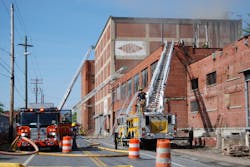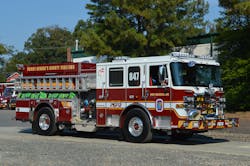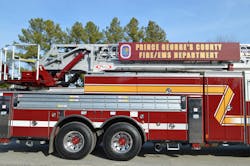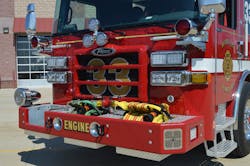There are many challenges that apparatus committees face when developing bid specifications for new units, including vehicle size, interior cab layout, fire pump rating, and water tank and hosebed capacities along with the tools and equipment that need to be carried. Aerial devices have various offerings with respect to vertical height, horizontal reach, rated tip load, outrigger stance and ground ladder configurations.
At times, the amount of variations and options are overwhelming and can result in poor decisions at the point of purchase.
Depending on the department’s fleet replacement plan and the anticipated life cycle for the apparatus, frontline units can be expected to provide at least 10 years of service—in some cases, considerably more. With this in mind, it is imperative early in the design process to determine and analyze the mission of the vehicle. Apparatus must be capable of safely operating in the response area along with carrying the personnel, tools and equipment to support fire/rescue incidents that you’re likely to encounter.
Safety and performance
Apparatus safety and performance should be at the forefront of any discussions about a vehicle’s overall design. One of the first factors to consider is community demographics. A 15-year-old vehicle that worked well for the department might be worthy of a repeat performance; however, it is unlikely that your community looks the same as it did in 2005. Roadways now have dedicated bike and bus lanes, roundabouts and heavier traffic patterns that affect our response routes. Many communities adopted minimum building set back requirements, including green space landscaping, which affects apparatus positioning and often limits access to one side of the structure.
Fire station access also should be considered, to verify apparatus bay door and interior clearances, ramp angles and roadway impediments that could restrict apparatus movements from the station. If the apparatus committee has any doubt as to a new vehicle's maneuverability, the committee should have a similar size and weight apparatus brought to the department to validate the capabilities of the vehicle with respect to front axle cramp angle, wall-to-wall turning radius, and approach and departure angles. It sounds rather straightforward, yet each year we hear about fire departments that acquire units that don’t fit into their station’s apparatus bays or are restricted from accessing parts of the response area because of roadway and bridge weight restrictions.
Many fire departments rely on multipurpose units to provide service delivery in their response areas. The result is that many pieces of fire apparatus, regardless of type, have become larger in size. Basic dimensions, such as overall length, overall height and the in-service weights of units, have become so large that the body configuration makes it difficult or unsafe to work from. Although NFPA 1901: Standard for Automotive Fire Apparatus provides some excellent guidelines, there is nothing in the standard that prevents an apparatus committee to specify a vehicle that would be too large, tall or heavy with respect to the operating conditions and demographics in the community.
When discussing the initial cost of the apparatus, you also must consider the life cycle operational costs for the heavier vehicle, which will affect tire wear, suspension components and potential limited access to equipment that’s stored in upper body compartments. Most importantly, location of properly located fixed steps, access ladders and handrails must be considered in the overall design of the vehicle. Simply put, what looks great on paper on the blueprint might not work well once the completed apparatus is delivered and placed into service.
Let’s consider your department’s deployment strategies with respect to apparatus response patterns to various types of incidents. Many organizations use GPS or other mapping programs to alert the closest staffed units, particularly for EMS incidents, which in many jurisdictions make up the large majority of all calls. During a recent fire service conference, several attendees discussed their department’s use of all suppression units to deliver paramedic-level EMS service in their community. The effect of running an 84,000-lb. rear-mount aerial tower to low-priority EMS calls, along with other responses that result in more than 3,500 annual responses, will result in increased maintenance and repair costs along with a reduction in the planned 15-year life cycle.
Engine company apparatus dimensions, including overall length, wheelbase and height, are driven by several factors, including cab seating, pump panel width, and water and foam tank capacities, along with the desired compartment layout and hosebed. A change in any one of these areas can affect adversely vehicle maneuverability, center of gravity and axle ratings. When developing specifications for any new apparatus, it is incumbent upon the fire department to develop a complete inventory of tools and equipment, including all hoseloads, which will be included in the bid documents. Included with this inventory will be the anticipated weight of this equipment. This protects the interests of the organization, because your equipment inventory might weigh considerably more than the allowances that are provided in NFPA 1901 for the different types of apparatus. Additionally, the fire department should require a detailed weight analysis for the apparatus as proposed by each manufacturer to ensure that the unit is built to carry your equipment with a margin for additional equipment that might be placed onto the apparatus during its life cycle.
The height of the rear hosebed on many engine units has increased because of the need to carry more equipment for any type of incident. Full-depth body compartments typically require a rectangular water tank; with everything else being equal, a combination rescue-engine apparatus that has a 750-gallon water tank will have a higher hose body than a unit that has a T-shaped water tank. Flat-back style bodies, while offering additional enclosed compartment space, can limit the available options for stepping arrangements for access to the hosebed area. Apparatus committees should review the availability and fire flows that are available from the public water supply when they determine the appropriate size of the water tank and the desired hosebed height from the ground. Using a combination of body length, tank dimensions and hosebed layout, there are opportunities to lower the hosebed and provide safe access to this area.
A visit to any local fire apparatus and equipment show might reinforce the notion that a moderate-wheelbase engine that’s outfitted with a rescue-engine body, a 1,000-gallon water tank, a generator, a light tower and the latest foam system technology will work for your department. Just because the apparatus will fit into the available space in the station doesn’t mean that it will perform well within the response district. The apparatus committee carefully should plan the overall layout of the apparatus and then add components that will enhance the mission of the vehicle.
Define the mission
When it comes to designing aerial apparatus, many of the challenges that the apparatus committee face can be overcome by defining the mission of the vehicle. This task requires addressing issues within the department’s apparatus committee, as well as among the chief officers, and reaching out to municipal stakeholders who affect regulations for building and zoning requirements. In the past decade, there has been a dramatic increase in the size of residential structures amid the introduction of lightweight building materials. A 10,000-square-foot, three-story home no longer can be considered a routine structural fire when the alarm comes in to your communications center. In many situations, access to the structure for aerial apparatus precludes use of the aerial device and increases the reliance on ground ladders to cover all four sides of the building. What appears to be a two-story home on sides one, two and four actually might be three or four stories at the rear of the building.
With so many kinds of aerial devices—rear-mounted aerial ladder, tractor-drawn aerial ladder, mid-mounted tower ladder, rear-mounted aerial tower—what do you choose? Doing a community-based aerial-needs assessment might be appropriate at this point to help to define the mission of the vehicle.
So, let’s say, as the apparatus committee, you determined a need for more than the NFPA-minimum 115 feet of ground ladders. Now, which style of aerial device and body configuration lends itself to the capability to carry the maximum number of portable ladders? What tower design leads to maximum payload of portable ladders? If your response district or the fire station has an overall height limitation, then a rear-mounted aerial tower might not be the best choice to meet your operational needs.
Mid-mounted tower ladders were developed for departments that have apparatus bay doors that are smaller than 11 feet and were built principally without a fire pump or water tank to maximize the equipment and ground ladder complements with a single-axle configuration. Over time, tandem-axle apparatus became more prevalent, which resulted in more quint units, where the size of the water tank and of the hosebed dictated the space that is available for ground ladders. This resulted in many quint apparatus that carry only two extension ladders.During your assessment of the structural conditions in the response district, evaluate the number of buildings where access to your current or planned aerial apparatus would be limited and then seek out the number and appropriate working length of ground ladders that you would need to protect not only potentially trapped occupants but department personnel as well. It isn’t uncommon for a well-designed truck company to carry 240–280 feet of portable ground ladders with tractor-drawn ladder units having more than 300 feet of ground ladders.
Perhaps the apparatus committee determines that the new aerial device must carry more than the NFPA-minimum of 2,500 pounds of equipment. Getting an accurate count of tools and equipment is critical in the design phase, not only to avoid an overweight condition but also to keep the vehicle in balance. Any model of quint apparatus can be subject to overloading if the tool and equipment cache is greater than what the apparatus manufacturer projected during the initial design process. Ensure that your department provides a detailed listing of the anticipated hose, tools and equipment that are planned to be carried on the vehicle to your apparatus sales representative. Next, ask for a detailed weight analysis for review and approval by all parties prior to contract to confirm that the apparatus design will meet your needs.
Consider these concepts during the initial design process of your engine and ladder company apparatus. Defining the mission of the vehicle and melding this with the operational needs of the fire department while staying within the organization’s fleet replacement plan will go a long way to ensuring a safe and well-designed apparatus. Your fire department and community deserve nothing less.
About the author
Tom Shand is a 37-year veteran of the fire service and works at Emergency Vehicle Response. He consults on a variety of fire apparatus and fire department master-planning issues.
About the Author

Tom Shand
TOM SHAND, who is a Firehouse contributing editor, is a 36-year veteran of the fire service. He works with Michael Wilbur at Emergency Vehicle Response, consulting on a variety of fire apparatus and fire department master-planning issues. Shand is a member of the Firehouse Hall of Fame.




